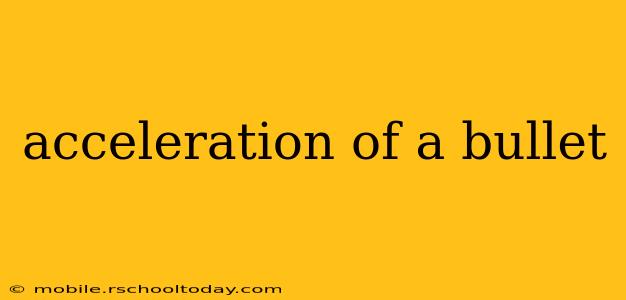Understanding how a bullet accelerates from a standstill inside a firearm's chamber to its incredible velocity at the muzzle is crucial for anyone interested in firearms, ballistics, or physics. This process is complex, involving a fascinating interplay of pressure, force, and the bullet's own properties. This article will delve into the physics behind a bullet's acceleration, exploring the key factors that influence its speed and trajectory.
The Role of Pressure: The Driving Force Behind Acceleration
The acceleration of a bullet begins the moment the firearm's firing pin strikes the primer. This initiates the rapid combustion of the propellant (gunpowder), generating an immense amount of pressure within the relatively confined space of the cartridge case. This pressure, measured in PSI (pounds per square inch), is the primary driving force behind the bullet's acceleration. It's important to note that this pressure isn't constant; it rises rapidly to a peak and then gradually falls as the bullet travels down the barrel.
Peak Pressure and its Significance
The peak pressure generated within the cartridge case is a critical factor determining the bullet's final velocity. Higher peak pressures generally lead to higher velocities, but exceeding the firearm's design limits can cause catastrophic failure. This is why understanding the pressure characteristics of different ammunition types is vital for safe and responsible firearm use. Manufacturers meticulously test and specify the pressure limits for their firearms.
The Barrel: Guiding and Accelerating the Projectile
The firearm's barrel isn't just a conduit for the bullet; it's a crucial component in its acceleration process. The barrel's rifling – the spiral grooves cut into its interior – imparts spin to the bullet, stabilizing its flight and enhancing accuracy. The bullet's interaction with the rifling also contributes to its acceleration, though this is a secondary effect compared to the pressure from the propellant gases.
Barrel Length and Velocity
Barrel length significantly impacts a bullet's final velocity. Longer barrels allow the propellant gases to exert force on the bullet for a longer period, resulting in higher muzzle velocities. However, there are diminishing returns; the increase in velocity gained from excessively long barrels often isn't proportional to the added length.
Factors Affecting Bullet Acceleration: Beyond Pressure and the Barrel
Several other factors influence a bullet's acceleration:
- Bullet Weight: Heavier bullets generally accelerate more slowly than lighter bullets, given the same propellant charge.
- Propellant Type and Quantity: The type and amount of propellant directly affect the pressure generated, thus influencing the bullet's acceleration.
- Bullet Design: The shape and construction of the bullet can affect its aerodynamic performance and therefore its acceleration and overall trajectory.
- Temperature and Humidity: Environmental conditions can subtly influence the propellant's burning rate and the pressure curve within the barrel.
Measuring and Analyzing Bullet Acceleration
Specialized equipment, such as chronographs, are used to measure a bullet's velocity at the muzzle. By knowing the bullet's mass and velocity, one can calculate its kinetic energy and understand its potential for impact. Ballistics experts utilize advanced techniques and sophisticated software to model and analyze bullet trajectories, factoring in all the above-mentioned variables.
Conclusion: A Complex Interaction of Forces
The acceleration of a bullet is a complex process involving a precise interplay of pressure, the firearm's design, and the bullet's physical properties. Understanding these interactions provides a deeper appreciation for the science behind firearms and the physics that govern projectile motion. Further research into specific firearm types and ammunition calibers can offer even more detailed insights into the nuances of bullet acceleration.
